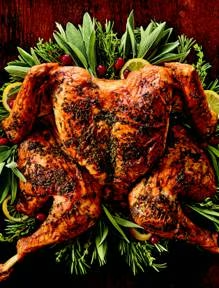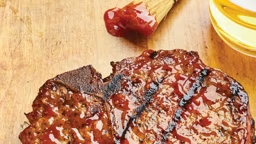After having many conversations with pit masters, I have gathered excellent tips for grilling different kinds of ribs right. Here are 10 bits of know-how to get you started.
1. In most of the U.S., pork ribs are king. Common varieties include: baby backs – small, uniformly sized, and very tender; spareribs – larger, tougher, and require more cooking time, but with more meat and flavor; and St. Louis ribs – spareribs with the soft “rib tips” section removed to create a more uniform, squared-off look. Country-style ribs are boneless, like a well-marbled pork chop.
2. If you think the best part of a steak is the meat around the bone, beef ribs are for you. Popular in Texas, beef back ribs are big – think dinosaur-sized – and can be tough and fatty. But, when grilled or smoked slowly over low, indirect heat, they are deliciously rich in flavor.
3. The tough membrane on the back of ribs should be removed before cooking. Using a knife, work up a corner; then, grasp the membrane with a paper towel or dishcloth, and pull firmly and steadily down the length of the rack.
4. Laying ribs flat takes up a lot of space on the grill. A rib rack accessory stand holds them upright, allowing twice as many racks to be cooked at once.
5. Myth buster: Experts say ribs should not have “fall-off-the-bone” texture. They should be tender enough to pull apart with your fingers, but the meat should still have a little resistance or “chew.”
6. To prevent ribs from drying out or absorbing too much smoke before they’re done, wrap them in foil halfway through cooking time. This traps moisture to steam the ribs and increases tenderness.
7. There are two rib philosophies: wet and dry. Dry proponents believe a spice rub is the only necessary seasoning and that sauces should be reserved as dipping condiments. Others prefer a saucy, sticky-finger-licking experience. For dry ribs, massage ample seasoning into the racks before cooking, and add another sprinkle before serving. Sauce lovers should apply it during the last 30 minutes of cooking, and then give it a quick caramelization directly over the heat before serving.
8. Another debate: to parboil or not? Most true pit masters would never parboil their ribs to render fat. Instead, long, slow cooking or smoking over indirect heat will accomplish this while adding lots of flavor.
9. Ribs are not to be rushed. Expect about 90 minutes (baby backs) to 3 hours (spareribs, St. Louis and beef) with indirect grilling at 300–350°F temperatures (with charcoal banked or a gas burner lit on one side only, and ribs placed opposite the heat). Smoking at 225–250°F temperatures might take 3–6 hours. It’s best to follow your recipe.
10. Some rib lovers can polish off an endless supply, but on average, a rack of pork baby backs serves two, spareribs three, and St. Louis-style two to three. For country-style pork ribs and beef back ribs, estimate two to three ribs per person.
1. In most of the U.S., pork ribs are king. Common varieties include: baby backs – small, uniformly sized, and very tender; spareribs – larger, tougher, and require more cooking time, but with more meat and flavor; and St. Louis ribs – spareribs with the soft “rib tips” section removed to create a more uniform, squared-off look. Country-style ribs are boneless, like a well-marbled pork chop.
2. If you think the best part of a steak is the meat around the bone, beef ribs are for you. Popular in Texas, beef back ribs are big – think dinosaur-sized – and can be tough and fatty. But, when grilled or smoked slowly over low, indirect heat, they are deliciously rich in flavor.
3. The tough membrane on the back of ribs should be removed before cooking. Using a knife, work up a corner; then, grasp the membrane with a paper towel or dishcloth, and pull firmly and steadily down the length of the rack.
4. Laying ribs flat takes up a lot of space on the grill. A rib rack accessory stand holds them upright, allowing twice as many racks to be cooked at once.
5. Myth buster: Experts say ribs should not have “fall-off-the-bone” texture. They should be tender enough to pull apart with your fingers, but the meat should still have a little resistance or “chew.”
6. To prevent ribs from drying out or absorbing too much smoke before they’re done, wrap them in foil halfway through cooking time. This traps moisture to steam the ribs and increases tenderness.
7. There are two rib philosophies: wet and dry. Dry proponents believe a spice rub is the only necessary seasoning and that sauces should be reserved as dipping condiments. Others prefer a saucy, sticky-finger-licking experience. For dry ribs, massage ample seasoning into the racks before cooking, and add another sprinkle before serving. Sauce lovers should apply it during the last 30 minutes of cooking, and then give it a quick caramelization directly over the heat before serving.
8. Another debate: to parboil or not? Most true pit masters would never parboil their ribs to render fat. Instead, long, slow cooking or smoking over indirect heat will accomplish this while adding lots of flavor.
9. Ribs are not to be rushed. Expect about 90 minutes (baby backs) to 3 hours (spareribs, St. Louis and beef) with indirect grilling at 300–350°F temperatures (with charcoal banked or a gas burner lit on one side only, and ribs placed opposite the heat). Smoking at 225–250°F temperatures might take 3–6 hours. It’s best to follow your recipe.
10. Some rib lovers can polish off an endless supply, but on average, a rack of pork baby backs serves two, spareribs three, and St. Louis-style two to three. For country-style pork ribs and beef back ribs, estimate two to three ribs per person.
 Thinkstock.com
Thinkstock.com 









